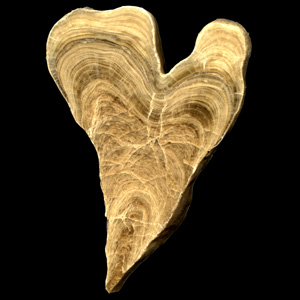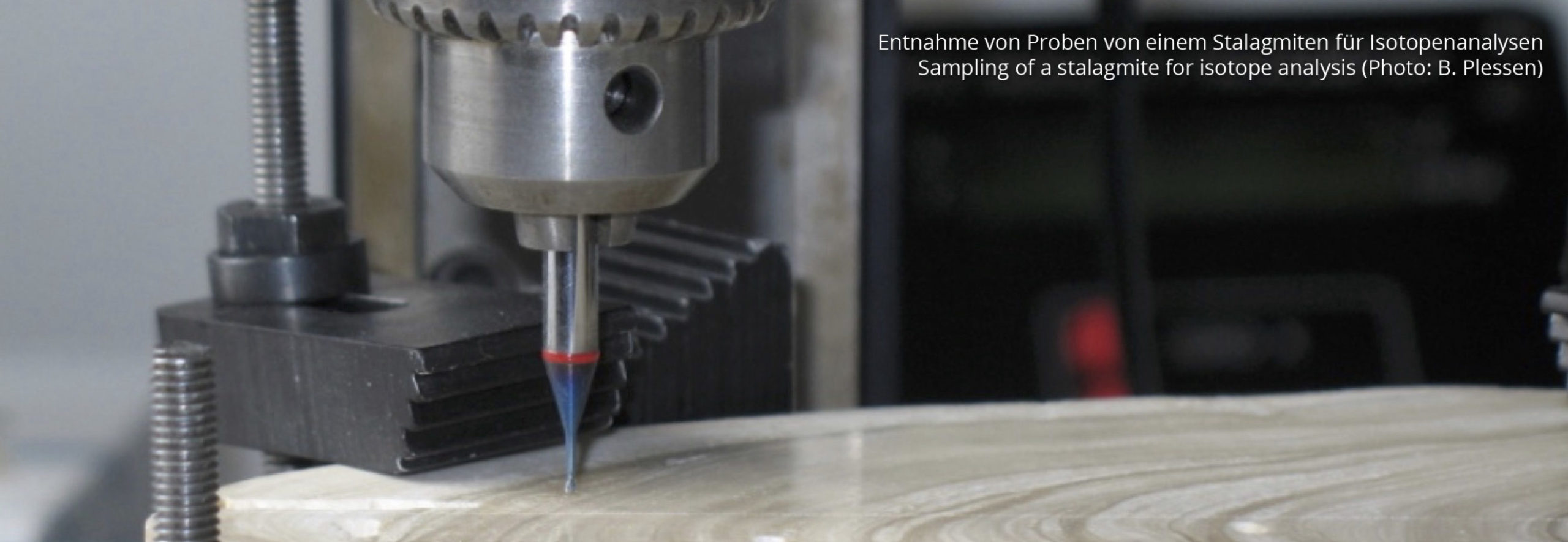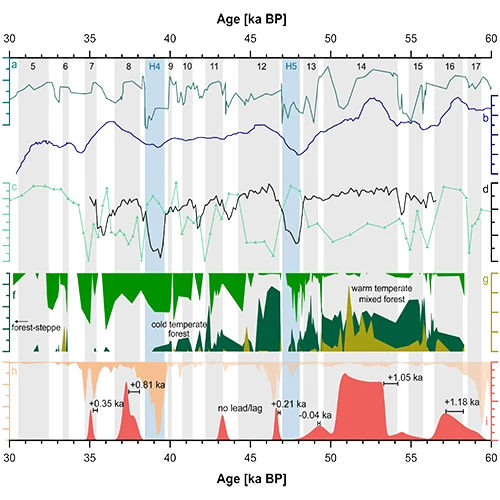Veröffentlichungen
2024
Zhang, Junjie; Klose, Jennifer; Scholz, Denis; Marwan, Norbert; Breitenbach, Sebastian F. M.; Katzschmann, Lutz; Kraemer, Dennis; Tsukamoto, Sumiko
Isothermal thermoluminescence dating of speleothem growth – A case study from Bleßberg cave 2, Artikel
In: Quaternary Geochronology, Bd. 85, S. 101628, 2024.
Abstract | Links | BibTeX | Schlagwörter: bb2-1, chronology, dating, jgu, liag, northumbria, pik, stalagmite, tl dating
@article{zhang2024,
title = {Isothermal thermoluminescence dating of speleothem growth – A case study from Bleßberg cave 2,},
author = {Junjie Zhang and Jennifer Klose and Denis Scholz and Norbert Marwan and Sebastian F. M. Breitenbach and Lutz Katzschmann and Dennis Kraemer and Sumiko Tsukamoto},
doi = {10.1016/j.quageo.2024.101628},
year = {2024},
date = {2024-09-21},
urldate = {2024-09-21},
journal = {Quaternary Geochronology},
volume = {85},
pages = {101628},
abstract = {Speleothems are a key archive of past climatic and environmental changes. 230Th/U dating is the most commonly used method to determine speleothem ages. However, incorporation of non-radiogenic thorium may hamper 230Th/U dating, and samples older than 600 ka also remain out-of-reach. Calcite exhibits a thermoluminescence (TL) signal at 280 °C with a high characteristic saturation dose, and provides significant potential to date carbonate samples over several million years. Hitherto, the application of TL dating for calcite has mainly been hindered by two factors: 1) a spurious TL signal occurring in the high temperature range, and 2) non-uniform dose rate due to U-series disequilibrium. Here we test an isothermal TL (ITL) dating method on a speleothem sample from Bleßberg cave 2, Germany. We show that the ITL signal measured at 240 °C can completely remove the 280 °C TL peak with a negligible TL contribution from the higher temperature range, thus reducing the influence from the spurious signal. The time-dependent dose rate variation can be simulated using the initial radioactivity of 238U, 234U, 230Th and their decay constants. We use the 230Th/U dating method to provide precise and accurate radiometric ages documenting that the speleothem grew between 425.5 ± 5.4 and 320.5 ± 9.7 ka. The ITL ages (421 ± 23 to 311 ± 23 ka) of four subsamples from the speleothem are consistent with the 230Th/U ages at isochronous sampling positions, showing the general reliability of the ITL dating method. ITL dating provides a pathway to construct chronologies for palaeoclimate reconstructions for speleothems beyond the range of the 230Th/U-method and for samples that are unsuitable for U-series dating methods.},
keywords = {bb2-1, chronology, dating, jgu, liag, northumbria, pik, stalagmite, tl dating},
pubstate = {published},
tppubtype = {article}
}
Klose, Jennifer
Quantitative multi-proxy climate reconstruction for MIS 3 in Central Europe based on precisely dated speleothems from Bleßberg Cave, Germany Promotionsarbeit
2024.
Abstract | Links | BibTeX | Schlagwörter: bb-10, bb-15, bb-9, bb2-1, jgu, palaeoclimate, stalagmite
@phdthesis{klose2023phd,
title = {Quantitative multi-proxy climate reconstruction for MIS 3 in Central Europe based on precisely dated speleothems from Bleßberg Cave, Germany},
author = {Jennifer Klose},
editor = {Johannes Gutenberg University Mainz},
url = {https://bbh.pik-potsdam.de/wp-content/uploads/2024/09/Klose_Thesis_Jennifer-Klose.pdf},
doi = {10.25358/openscience-10558},
year = {2024},
date = {2024-05-01},
urldate = {2024-05-01},
abstract = {Speläotheme zeichnen sich als sensitive Klimaarchive aus und haben sich in letzten
Jahrzehnten als solche etabliert. Sie haben das Potential wertvolle Informationen über das
Paläoklima kontinuierlich aufzuzeichnen und können mit den Uran-
Ungleichgewichtsmethoden präzise datiert werden. Das Berechnen von unabhängigen
Altersmodellen kombiniert mit Analysen verschiedener Klimaproxys, wie δ18O und δ13C,
Spurenelementen oder Tropfwassereinschlüssen ermöglicht es, hochaufgelöste
Paläoklimarekonstruktionen zu erstellen.
Dansgaard-Oeschger (DO)-Ereignisse sind kurzfristige Klimaschwankungen über
einige hunderte oder wenige tausende Jahre, welche vor allem während der marinen
Isotopenstufe 3 (MIS 3, ca. 60 - 30 ka BP) auftraten. Obwohl erste Beweise für die
Ereignisse in grönländischen Eisbohrkernen entdeckt wurden, sind sie mittlerweile global
nachweisbar. DO-Ereignisse zeichnen sich durch eine rasche Erwärmung, gefolgt von
gradueller Abkühlung aus, während das MIS 3 generell als eine kältere Periode definiert
ist. Daher wurde die Tatsache, dass bisher kaum zentraleuropäische Speläotheme aus dem
MIS 3 gefunden wurden, mit zu kaltem oder trockenem Klima begründet. Im Rahmen
dieser Arbeit wurden drei MIS 3 Speläotheme aus der Bleßberg Höhle in Deutschland
detailliert untersucht. Durch die Kombination von lösungs-basierter und in-situ
Laserablation 230Th/U-Datierung konnte das komplexe Wachstum der Proben präzise
aufgeschlüsselt werden.
Es konnten mehrere Wachstumsepisoden im MIS 3 identifiziert werden, welche primär
zeitgleich zu DO-Ereignissen in Grönland auftraten. Die Wachstumsphasen wurde daher
als eigenständiger Proxy für günstige Klimabedingungen für Speläothemwachstum
etabliert, d.h. Perioden mit ausreichender Boden- und Vegetationsbedeckung über der
Höhle und der Möglichkeit das Tropfwasser in die Höhle gelangt. Darüber hinaus wurde
eine multi-Proxy Analyse durchgeführt mit dem Ziel möglichst vielfältige Informationen
über das MIS 3 in Mitteleuropa zu erhalten. Ein langfristiger Trend zeigt die generelle
Verschlechterung des Klimas mit Fortschreiten des MIS 3 auf. Eine besonders warme und
kontinuierliche Wachstumsphase trat zeitgleich mit DO14 auf. Außerdem wurden zwei
kurzzeitige Kälteereignisse innerhalb des DO14 aufgezeichnet, welches die hohe
Sensitivität der Speläotheme aus der Bleßberg Höhle verdeutlicht.
Weitere kurzzeitige Klimaereignisse wurden während des spätglazialen Teils der
Speläothem-Proben (ca. 14,5 - 1,7 ka BP) aufgezeichnet und ein hochauflösender multi-
Proxy-Datensatz, der das Holozän (11,7 ka BP - rezent) bis 0,6 ka BP abdeckt, wurde
erstellt.},
keywords = {bb-10, bb-15, bb-9, bb2-1, jgu, palaeoclimate, stalagmite},
pubstate = {published},
tppubtype = {phdthesis}
}
Jahrzehnten als solche etabliert. Sie haben das Potential wertvolle Informationen über das
Paläoklima kontinuierlich aufzuzeichnen und können mit den Uran-
Ungleichgewichtsmethoden präzise datiert werden. Das Berechnen von unabhängigen
AltersmodellenAltersmodell Nach der Datierung eines Stalagmiten werden allen anderen Messungen (z. B. Isotopenverhältnisse), die ursprünglich entlang einer Längen-Achse durchgeführt wurden, ein Alter zugeordnet. kombiniert mit Analysen verschiedener Klimaproxys, wie δ18O und δ13C,
Spurenelementen oder Tropfwassereinschlüssen ermöglicht es, hochaufgelöste
Paläoklimarekonstruktionen zu erstellen.
Dansgaard-Oeschger (DO)-Ereignisse sind kurzfristige Klimaschwankungen über
einige hunderte oder wenige tausende Jahre, welche vor allem während der marinen
Isotopenstufe 3 (MIS 3MIS 3 "MIS" ist die Abkürzung für "marine isotope stage", übersetzt also "Isotopenstadium mariner Sedimente". Da sich beim Wechsel von Warm- zu Kaltzeiten (und umgekehrt) die Isotopenverhältnisse in den Kalkschalen kleiner Einzeller (Foraminiferen) auf dem Meeresboden ändern, werden diese zur Datierung herangezogen und lassen sich zur Eingruppierung verschiedener Klimazustände in der Vergangenheit nutzen. "MIS 3" bedeutet dabei eine kurzzeitige Warmphase (beginnend vor 57 Tausend Jahren) während der letzten Eiszeit., ca. 60 - 30 ka BPka BP Mit "ka BP" sind "Tausend Jahre vor 1950" gemeint. Das "BP" steht für "before present", was in der Paläoklima-Wissenschaft als 1950 festgelegt wurde. "11.000 ka BP" bedeuted also 11 Tausend Jahre vor 1950, oder unter Verwendung unseres gewohnten Kalenders: 9050 v. Chr.) auftraten. Obwohl erste Beweise für die
Ereignisse in grönländischen Eisbohrkernen entdeckt wurden, sind sie mittlerweile global
nachweisbar. DO-Ereignisse zeichnen sich durch eine rasche Erwärmung, gefolgt von
gradueller Abkühlung aus, während das MIS 3 generell als eine kältere Periode definiert
ist. Daher wurde die Tatsache, dass bisher kaum zentraleuropäische Speläotheme aus dem
MIS 3 gefunden wurden, mit zu kaltem oder trockenem Klima begründet. Im Rahmen
dieser Arbeit wurden drei MIS 3 Speläotheme aus der Bleßberg Höhle in Deutschland
detailliert untersucht. Durch die Kombination von lösungs-basierter und in-situ
Laserablation 230Th/U-DatierungDatierung Um einem Stalagmiten oder gar einer einzelnen Wachstumslage im Stalagmiten ein Alter zuordnen zu können, muß eine Datierung durchgeführt werden. Dies erfolgt in der Regel radiometrisch, d. h. über die Messung von Zerfallsprodukten (siehe auch U/Th-Datierung). konnte das komplexe Wachstum der Proben präzise
aufgeschlüsselt werden.
Es konnten mehrere Wachstumsepisoden im MIS 3 identifiziert werden, welche primär
zeitgleich zu DO-Ereignissen in Grönland auftraten. Die Wachstumsphasen wurde daher
als eigenständiger ProxyProxy Umwelt- und Klimainformationen aus der Vergangenheit sind nicht direkt verfügbar, weil niemand da war, der diese messen und aufzeichnen konnte. Daher ist man darauf angewiesen, diese Informationen indirekt aus anderen Informationen abzuleiten, wie z. B. Baumringe, das Verhältnis von Sauerstoffisotopen, Spurenelementen, Mächtigkeit von Sedimentschichten usw. Diese Art von Daten nennt man Proxies, was aus dem englischen stammt und „Stellvertreter“ bedeutet. für günstige Klimabedingungen für Speläothemwachstum
etabliert, d.h. Perioden mit ausreichender Boden- und Vegetationsbedeckung über der
Höhle und der Möglichkeit das Tropfwasser in die Höhle gelangt. Darüber hinaus wurde
eine multi-ProxyProxy Umwelt- und Klimainformationen aus der Vergangenheit sind nicht direkt verfügbar, weil niemand da war, der diese messen und aufzeichnen konnte. Daher ist man darauf angewiesen, diese Informationen indirekt aus anderen Informationen abzuleiten, wie z. B. Baumringe, das Verhältnis von Sauerstoffisotopen, Spurenelementen, Mächtigkeit von Sedimentschichten usw. Diese Art von Daten nennt man Proxies, was aus dem englischen stammt und „Stellvertreter“ bedeutet. Analyse durchgeführt mit dem Ziel möglichst vielfältige Informationen
über das MIS 3 in Mitteleuropa zu erhalten. Ein langfristiger Trend zeigt die generelle
Verschlechterung des Klimas mit Fortschreiten des MIS 3 auf. Eine besonders warme und
kontinuierliche Wachstumsphase trat zeitgleich mit DO14 auf. Außerdem wurden zwei
kurzzeitige Kälteereignisse innerhalb des DO14 aufgezeichnet, welches die hohe
Sensitivität der Speläotheme aus der Bleßberg Höhle verdeutlicht.
Weitere kurzzeitige Klimaereignisse wurden während des spätglazialen Teils der
SpeläothemSpeläothem Sekundäre Mineralablagerungen in Höhlen, wie Sinter, Stalagmiten, Stalaktiten, usw.-Proben (ca. 14,5 - 1,7 ka BP) aufgezeichnet und ein hochauflösender multi-
Proxy-Datensatz, der das HolozänHolozän Der jüngste Abschnitt der geologischen Zeitgeschichte, etwa die letzten 11.700 Jahre. (11,7 ka BP - rezent) bis 0,6 ka BP abdeckt, wurde
erstellt.
2023
Zhang, J.; Klose, J.; Sierralta, M.; Tsukamoto, S.; Scholz, D.; Marwan, N.; Breitenbach, S.
Isothermal thermoluminescence (ITL) dating of a speleothem from Bleßberg Cave Vortrag
29.06.2023, (17th International Luminescence and Electron Spin Resonance Dating conference (LED2023), Copenhagen (Denmark)).
Abstract | BibTeX | Schlagwörter: bb2-1, dating, liag, stalagmite, tl dating
@misc{zhang2023,
title = {Isothermal thermoluminescence (ITL) dating of a speleothem from Bleßberg Cave},
author = {J. Zhang and J. Klose and M. Sierralta and S. Tsukamoto and D. Scholz and N. Marwan and S. Breitenbach},
editor = {17th International Luminescence and Electron Spin Resonance Dating conference (LED2023), Copenhagen (Denmark)},
year = {2023},
date = {2023-06-29},
urldate = {2023-06-29},
abstract = {The calcite thermoluminescence (TL) signal (280 °C peak) saturates at much higher doses (saturation dose up to 5000 Gy) compared to quartz and feldspar, which shows great potential to extend the dating limit. However, spurious TL signal occurred at the high temperature range hindered its application. The conventional multiple-aliquot additive-dose (MAAD) protocol used for TL dating applies extrapolation for equivalent dose (De) estimation, which also has large error. Isothermal TL (ITL) dating with the single-aliquot regenerative-dose (SAR) protocol might be a promising way as it reduces the influence of the spurious TL signal, and it applies interpolation to obtain the De. However, this protocol has not been tested on samples with independent age control.
This study tests the ITL SAR dating protocol on a speleothem sample from Bleßberg cave, which has been accurately dated with 230Th/U (ca. 320–425 ka). ITL measurement at 235 °C for 200 °C can remove the 280 °C TL peak completely without TL contribution from higher temperature range. ITL De shows a plateau when the ITL temperature varies between 230 °C and 240 °C. Peak shifting and isothermal annealing tests indicate the 280 °C TL peak has a lifetime of tens of millions years at 10 °C, which is stable enough for the age range of this speleothem sample. The accurate alpha efficiency (α-value) and the U, Th distribution within the sample are measured to estimate the dose rate. The dose rate variation with time due to U-series disequilibrium is corrected for. The ITL ages are compared with the 230Th/U ages to evaluate the performance of the ITL dating protocol.},
note = {17th International Luminescence and Electron Spin Resonance Dating conference (LED2023), Copenhagen (Denmark)},
keywords = {bb2-1, dating, liag, stalagmite, tl dating},
pubstate = {published},
tppubtype = {presentation}
}
This study tests the ITL SAR dating protocol on a speleothem sample from Bleßberg cave, which has been accurately dated with 230Th/U (ca. 320–425 ka). ITL measurement at 235 °C for 200 °C can remove the 280 °C TL peak completely without TL contribution from higher temperature range. ITL De shows a plateau when the ITL temperature varies between 230 °C and 240 °C. Peak shifting and isothermal annealing tests indicate the 280 °C TL peak has a lifetime of tens of millions years at 10 °C, which is stable enough for the age range of this speleothem sample. The accurate alpha efficiency (α-value) and the U, Th distribution within the sample are measured to estimate the dose rate. The dose rate variation with time due to U-series disequilibrium is corrected for. The ITL ages are compared with the 230Th/U ages to evaluate the performance of the ITL dating protocol.

Kühne, Sofia
Spurenelementanalyse eines Speläothems der Marinen Isotopenstadien 9 und 11 aus der Blessberghöhle Bachelorarbeiten
Johannes-Gutenberg-Universität Mainz, 2023.
Abstract | Links | BibTeX | Schlagwörter: bb2-1, jgu, stalagmite
@bachelorthesis{kuehne2023,
title = {Spurenelementanalyse eines Speläothems der Marinen Isotopenstadien 9 und 11 aus der Blessberghöhle},
author = {Sofia Kühne},
url = {https://bbh.pik-potsdam.de/wp-content/uploads/2024/09/Bachelorarbeit_Sofia_Kuehne_2753456.pdf},
year = {2023},
date = {2023-01-01},
urldate = {2023-01-01},
school = {Johannes-Gutenberg-Universität Mainz},
abstract = {Die vorliegende Arbeit befasst sich mit einem Speläothem aus der Blessberghöhle in Thüringen. Diese Probe hatte jeweils eine Wachstumsphase während des Marinen Isotopenstadiums 11 und während des Marinen Isotopenstadiums 9. Dazwischen scheint es zu einem Wachstumsstopp gekommen zu sein. Die Probe wurde bereits datiert und auf Sauerstoff- und Kohlenstoffisotope untersucht, wobei im Rahmen dieser Arbeit zusätzlich die Spurenelemente gemessen wurden. Durch die Interpretation dieser Daten lassen sich Schlüsse über das Klima ziehen. Allerdings ist die genaue Analyse der Daten komplex, weshalb der Vergleich mit globalen Klimatrends von großer Bedeutung ist.
Für das MIS 11 deuten die Daten auf eine sich verändernde Umwelt in Richtung trockeneres und vegetationsärmeres Klima hin, das aufgrund der abflachenden globalen Temperatur zu dieser Zeit erklärt werden kann. Es lässt sich anhand von einer schnelleren Wachstumsrate auf erhöhten Niederschlag während des Wachstums schließen, im Gegensatz zum MIS 9. Im Bezug auf das MIS 9 sind keine eindeutigen Schlussfolgerungen möglich, doch das stabile Verhalten der Werte lässt darauf schließen, dass das Klima während des Höhepunkts des MIS 9-Wachstums (9e) nur geringe Veränderungen aufwies. Diese sind nicht eindeutig zu interpretieren, da unterschiedliche Argumente für oder gegen Vegetationswachstum und Niederschlagsmengen vorliegen.
Es ist jedoch zu berücksichtigen, dass die Interpretation der vorliegenden Daten Unsicherheiten birgt. Zusätzliche Informationen wie ein Vergleich zu Proben aus der Höhle, die zur gleichen Zeit wuchsen, sowie mehr Wissen über lokale Faktoren, die die Höhlenbedingungen beeinflusst haben und weitere Altersdatierungen könnten zu einer akkurateren Deutung führen. Daher wären weitere Forschungsarbeiten erforderlich, um die aufgestellten Vermutungen zu verifizieren und um ein umfassenderes Bild der vergangenen Gegebenheiten zu erhalten.},
keywords = {bb2-1, jgu, stalagmite},
pubstate = {published},
tppubtype = {bachelorthesis}
}
Für das MISMIS "MIS" ist die Abkürzung für "marine isotope stage", übersetzt also "Isotopenstadium mariner Sedimente". Da sich beim Wechsel von Warm- zu Kaltzeiten (und umgekehrt) die Isotopenverhältnisse in den Kalkschalen kleiner Einzeller (Foraminiferen) auf dem Meeresboden ändern, werden diese zur Datierung herangezogen und lassen sich zur Eingruppierung verschiedener Klimazustände in der Vergangenheit nutzen. Die MIS werden rückwärts nummeriert (also größere Zahl = älter) und ungerade Zahlen stehen für Warmzeiten, gerade für Kaltzeiten. 11 deuten die Daten auf eine sich verändernde Umwelt in Richtung trockeneres und vegetationsärmeres Klima hin, das aufgrund der abflachenden globalen Temperatur zu dieser Zeit erklärt werden kann. Es lässt sich anhand von einer schnelleren Wachstumsrate auf erhöhten Niederschlag während des Wachstums schließen, im Gegensatz zum MIS 9. Im Bezug auf das MIS 9 sind keine eindeutigen Schlussfolgerungen möglich, doch das stabile Verhalten der Werte lässt darauf schließen, dass das Klima während des Höhepunkts des MIS 9-Wachstums (9e) nur geringe Veränderungen aufwies. Diese sind nicht eindeutig zu interpretieren, da unterschiedliche Argumente für oder gegen Vegetationswachstum und Niederschlagsmengen vorliegen.
Es ist jedoch zu berücksichtigen, dass die Interpretation der vorliegenden Daten Unsicherheiten birgt. Zusätzliche Informationen wie ein Vergleich zu Proben aus der Höhle, die zur gleichen Zeit wuchsen, sowie mehr Wissen über lokale Faktoren, die die Höhlenbedingungen beeinflusst haben und weitere Altersdatierungen könnten zu einer akkurateren Deutung führen. Daher wären weitere Forschungsarbeiten erforderlich, um die aufgestellten Vermutungen zu verifizieren und um ein umfassenderes Bild der vergangenen Gegebenheiten zu erhalten.
2022

Geier, Florian
230Th/U – Datierung eines Speläothems der Marinen Isotopenstadien 9 und 11 aus der Bleßberghöhle in Thüringen Bachelorarbeiten
Johannes-Gutenberg-Universität Mainz, 2022.
Abstract | Links | BibTeX | Schlagwörter: bb2-1, chronology, dating, jgu, stalagmite
@bachelorthesis{geier2022,
title = {^{230}Th/U – Datierung eines Speläothems der Marinen Isotopenstadien 9 und 11 aus der Bleßberghöhle in Thüringen},
author = {Florian Geier},
url = {https://bbh.pik-potsdam.de/wp-content/uploads/2024/09/Bachelorarbeit-Florian-Geier-2744515.pdf},
year = {2022},
date = {2022-06-01},
urldate = {2022-06-01},
school = {Johannes-Gutenberg-Universität Mainz},
abstract = {Im Zuge des gegenwärtigen Klimawandels gewinnen Rekonstruktionen des vergangenen Klimas zunehmend an Bedeutung, da durch sie klimatische Entwicklungen besser verstanden werden können. Speläotheme bilden ein terrestrisches Archiv, welche mittels der 230Th/U-Datierung absolut und sehr präzise datiert werden können. Die datierten Wachstumsphasen von Speläothemen liefern unmittelbar Rückschlüsse auf vergangene klimatische Gegebenheiten, da ihr Wachstum von der Tropfwasser- und damit der Niederschlagswasserverfügbarkeit abhängen. Aus diesen Wachstumsphasen lassen sich wärmere und feuchtere Zeiträume abgrenzen (Interglaziale). Der Stalagmit BB2‘1 aus der Bleßberghöhle im südlichen Thüringen wurde mit dieser Methode datiert. Sein Wachstum fand in den Interglazialen Marines Isoptenstadium (MIS) 11e-c und MIS 9e statt. Besonders im MIS 11e wurde viel Wachstum des BB2‘1 verzeichnet. Im Vergleich mit anderen Klimaarchiven können die klimatischen Bedingungen um die Bleßberghöhle in einen globalen Kontext gesetzt werden. Es zeigt sich, dass das Klima um die Bleßberghöhle an globale, klimatische Veränderungen gekoppelt war und sehr früh auf diese reagierte.},
keywords = {bb2-1, chronology, dating, jgu, stalagmite},
pubstate = {published},
tppubtype = {bachelorthesis}
}
2015

Sierralta, Melanie; Katzschmann, Lutz; Nikonow, Wilhelm; Rammlmair, Dieter
Insights in Bleßberg cave: Speleothem chronology and geochemical research Proceedings Article
In: 75. Jahrestagung der Deutsche Geophysikalische Gesellschaft in Hannover, 2015.
Abstract | BibTeX | Schlagwörter: bb2-1, chronology, liag, stalagmite
@inproceedings{sierralta2015,
title = {Insights in Bleßberg cave: Speleothem chronology and geochemical research},
author = {Melanie Sierralta and Lutz Katzschmann and Wilhelm Nikonow and Dieter Rammlmair},
year = {2015},
date = {2015-03-23},
booktitle = {75. Jahrestagung der Deutsche Geophysikalische Gesellschaft in Hannover},
abstract = {During construction works on the railway network between Ebensfeld and Erfurt a karst cave was found in the Bleßberg tunnel. The so called „Bleßberg Cave“ developed in limestone of the Lower Muschelkalk. The investigations by the Geological Survey of Thuringia (TLUG), the mining agency of Thuringia, and the incorporated society of cave explorer in Thuringia revealed impressing objects (stalagmites, stalactites, sinter, excentriques, cave lake, cave creek), which were partly sampled; furthermore the extent of the cave was measured. The more than 1000 m long cave had no natural entrance. Based on interdisciplinary studies on the sampled material information about the development and age of the cave will be obtained. Speleothem represent an impressive and unique archive for climate and palaeoenvironmental changes. The growth of stalagmites can be linked to warm climate phases of past. In these warm stages, the growth of stalagmites depends on the precipitation and the water supply; thus palaeoenvironmental conditions are preserved. The aim of this study is to decode the environmental condi- tions using high resolution techniques. Selected stalagmites and sinters were radiometrically dated by 230Th/U and analysed for their stable isotopic compositions. Furthermore, micro-energy dispersive X-ray fluorescence analyses were performed to evaluate trace element dis- tribution and identify growth phases of the speleothem. Most elements revealed the layered texture of the specimen while distribution of Al recorded the fractures. Some visibly identified hiatuses could be associated with changes in chemistry (Si, Fe). The determined 230Th/U ages on several speleothem samples range between 6 ka and 360 ka. In combination with high res- olution stable isotope investigation they provide insights into climatic changes from MIS 11 to the Holocene.},
keywords = {bb2-1, chronology, liag, stalagmite},
pubstate = {published},
tppubtype = {inproceedings}
}


